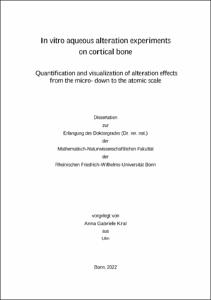In vitro aqueous alteration experiments on cortical boneQuantification and visualization of alteration effects from the micro- down to the atomic scale

In vitro aqueous alteration experiments on cortical bone
Quantification and visualization of alteration effects from the micro- down to the atomic scale

| dc.contributor.advisor | Geisler-Wierwille, Thorsten | |
| dc.contributor.author | Kral, Anna Gabriele | |
| dc.date.accessioned | 2022-10-14T09:18:47Z | |
| dc.date.available | 2023-11-01T23:00:16Z | |
| dc.date.issued | 14.10.2022 | |
| dc.identifier.uri | https://hdl.handle.net/20.500.11811/10361 | |
| dc.description.abstract | This dissertation addresses the effects of early diagenetic processes on vertebrate bone's organic and inorganic constituents in an aquatic environment. For this purpose, in vitro alteration experiments were performed on compact long bone material from a modern ostrich, as only recent bone allows before-and-after comparison in the context of diagenetic studies. The controlled experiments were performed on 3.5 mm-sized cylindrical cortical bone (CB) samples immersed in different aqueous solutions under simulated early diagenetic conditions. The variable parameters of the experiments were (1) temperature, (2) experimental duration, and (3) solution composition. Experiments were conducted at 30, 60, and 90 °C for up to 30 days in seawater (SW) and two different freshwater (FW) solutions with additional artificial sediment added to one of the freshwater solutions (FWS). After completion of the in vitro experiments, the bone samples and the corresponding experimental solutions were analyzed using state-of-the-art analytical methods: micro-computed tomography (µCT), electron microprobe analyzer (EMPA), nanoscale secondary ion mass spectrometry (nanoSIMS), atom probe tomography (APT), inductively coupled plasma-mass spectrometry (ICP-MS), Raman spectroscopy, and isotope ratio infrared spectrometry (IRIS). In the first part of the present work, µCT was used to perform a detailed quantitative and qualitative characterization of the bone samples in 3D before and after the experiments. The results showed that the internal bone structure was barely changed under the different conditions. Only the samples from the FW experiments showed an increased weight loss with increasing experiment duration. Here, the loss of collagen rather than the dissolution of the mineral phase is assumed to be the causative factor since neither an increase in bone porosity nor an increase in calcium and phosphorus concentrations in the solution was observed. Furthermore, a bright reaction rim (RR) was detected by µCT in the same FW samples. Based on these data, chemical and mineralogical analyses were performed, described in the second part of this dissertation. Here, it was shown that the RR is caused by enrichment with heavy elements, which was already measurable shortly after the beginning of the experiments. Lighter elements were not only concentrated in the RR but also distributed into the bone through the cortical canals. However, the processes leading to the accumulation of elements in the CB are not purely diffusive as previously assumed but rather involve transport and reaction processes. In addition, new apatite was formed at least in the RR of the bone samples, which is chemically and mineralogically different from the original bioapatite. In the experiments presented in the third part of this dissertation, the FW and SW solutions enriched with the isotope 18O and the FWS solution with additional sediment containing calcium hydrogen phosphate labeled with 18O were used to assess the growth of new apatite. This revealed that new fluorapatite was formed only in the bone samples that were in contact with sediment and not in those samples that were only in contact with an 18O-enriched solution without an external phosphate source. Based on the present work results, it was possible to derive a detailed phenomenological model describing the interactions between bone and aqueous solutions in an early diagenetic setting. | en |
| dc.language.iso | eng | |
| dc.rights | Namensnennung 4.0 International | |
| dc.rights.uri | http://creativecommons.org/licenses/by/4.0/ | |
| dc.subject | fossilization | |
| dc.subject | taphonomy | |
| dc.subject | early diagenesis | |
| dc.subject | bone | |
| dc.subject | aqueous | |
| dc.subject | alteration | |
| dc.subject | bone diagenesis | |
| dc.subject | collagen | |
| dc.subject | bioapatite | |
| dc.subject | raman spectroscopy | |
| dc.subject | nanoSIMS | |
| dc.subject | hydroxylapatite | |
| dc.subject | microstructure | |
| dc.subject | composition | |
| dc.subject | oxygen isotopes | |
| dc.subject.ddc | 550 Geowissenschaften | |
| dc.title | In vitro aqueous alteration experiments on cortical bone | |
| dc.title.alternative | Quantification and visualization of alteration effects from the micro- down to the atomic scale | |
| dc.type | Dissertation oder Habilitation | |
| dc.publisher.name | Universitäts- und Landesbibliothek Bonn | |
| dc.publisher.location | Bonn | |
| dc.rights.accessRights | openAccess | |
| dc.identifier.urn | https://nbn-resolving.org/urn:nbn:de:hbz:5-68375 | |
| dc.relation.doi | https://doi.org/10.3389/feart.2021.609496 | |
| dc.relation.doi | https://doi.org/10.1016/j.chemgeo.2022.121060 | |
| ulbbn.pubtype | Erstveröffentlichung | |
| ulbbnediss.affiliation.name | Rheinische Friedrich-Wilhelms-Universität Bonn | |
| ulbbnediss.affiliation.location | Bonn | |
| ulbbnediss.thesis.level | Dissertation | |
| ulbbnediss.dissID | 6837 | |
| ulbbnediss.date.accepted | 30.09.2022 | |
| ulbbnediss.institute | Mathematisch-Naturwissenschaftliche Fakultät : Fachgruppe Erdwissenschaften / Institut für Geowissenschaften | |
| ulbbnediss.fakultaet | Mathematisch-Naturwissenschaftliche Fakultät | |
| dc.contributor.coReferee | Tütken, Thomas | |
| ulbbnediss.contributor.orcid | https://orcid.org/0000-0002-8374-3488 | |
| ulbbnediss.date.embargoEndDate | 01.11.2023 |
Dateien zu dieser Ressource
Das Dokument erscheint in:
-
E-Dissertationen (4369)




